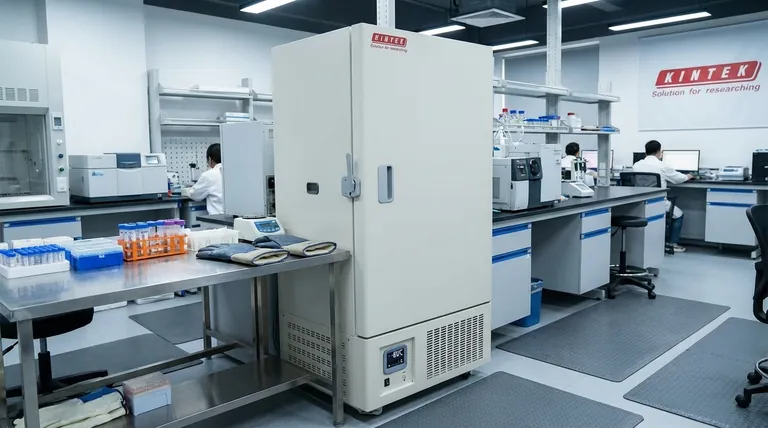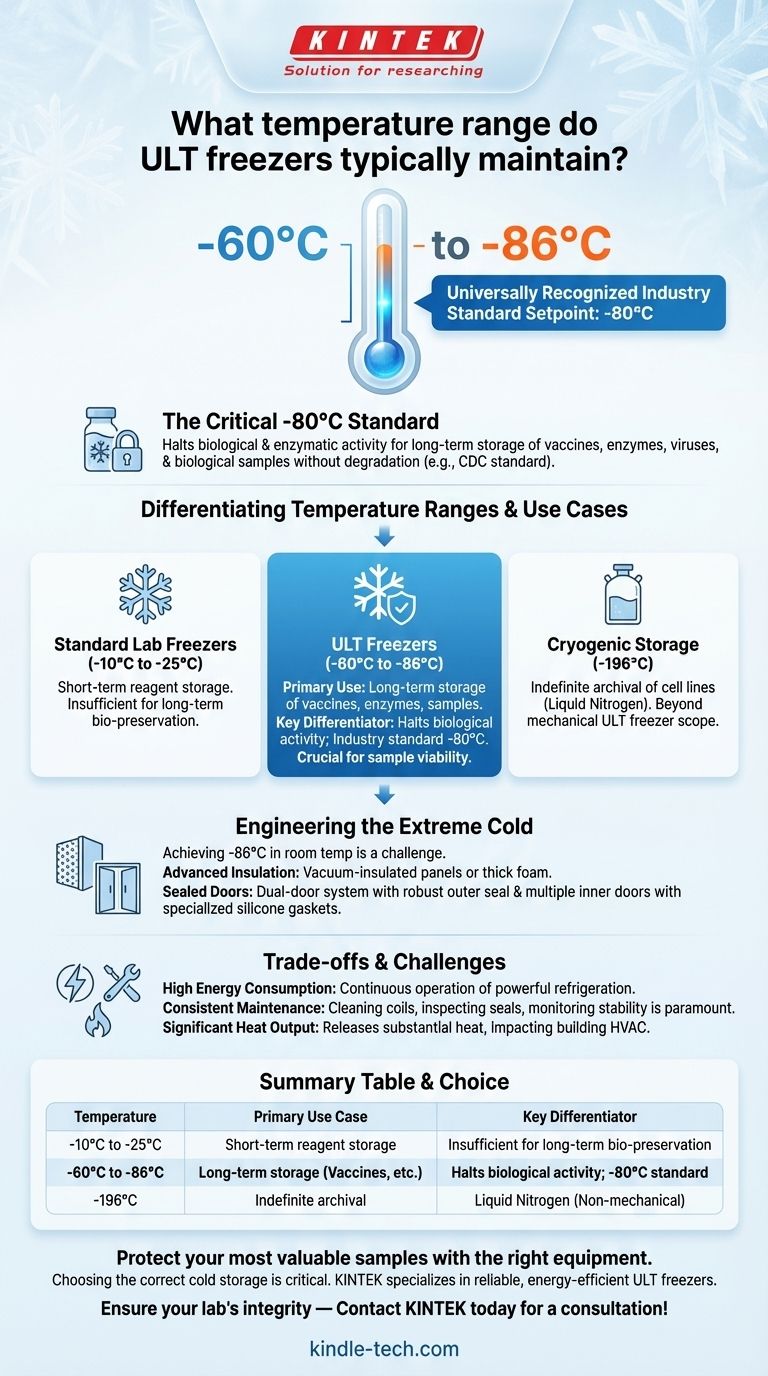At their core, Ultra-Low Temperature (ULT) freezers are engineered to maintain stable temperatures in the range of -60°C to -86°C. While specifications can vary, the universally recognized industry standard setpoint for these units is -80°C, which is critical for the long-term preservation of sensitive biological materials.
While the term "ultra-low" covers a spectrum, the true purpose of a ULT freezer is to reliably hold temperatures at or below -80°C. This specific temperature threshold is what separates them from standard laboratory freezers and is essential for halting biological activity and ensuring the long-term viability of samples.

What Defines an "Ultra-Low" Temperature?
The term "ULT" isn't just about being cold; it's about reaching a specific thermal state required for modern biological science and medicine. Understanding this distinction is key to selecting the correct equipment.
The Critical -80°C Standard
The -80°C setpoint is the most common operational temperature for a ULT freezer. This standard, often cited by organizations like the CDC, is considered the necessary temperature for the long-term storage of vaccines, enzymes, viruses, and other biological samples without degradation.
At this temperature, nearly all biological and enzymatic activity ceases, effectively placing samples in a state of suspended animation.
Differentiating from Standard Lab Freezers
It is crucial not to confuse ULT freezers with standard laboratory or pharmacy freezers. Those units typically operate in a range of -10°C to -25°C.
While suitable for short-term storage or less sensitive reagents, this temperature range is insufficient for preventing the long-term degradation of complex biological materials like RNA or proteins.
Beyond ULT: The Role of Cryogenic Storage
Some sources mention temperatures as low as -196°C. This refers to cryogenic storage, which uses liquid nitrogen, not mechanical compressors. This is a distinct class of preservation technology used for the indefinite storage of cell lines and other irreplaceable samples, and it represents a step beyond the capabilities of a standard ULT freezer.
The Engineering Behind Sustaining Extreme Cold
Achieving and maintaining -86°C in a room-temperature environment is a significant engineering challenge. The design of a ULT freezer is focused entirely on thermal stability and efficiency.
Advanced Insulation
The walls of a ULT freezer are packed with high-performance insulation, typically a vacuum-insulated panel or thick polyurethane foam. This minimizes heat transfer from the outside environment into the cold chamber.
A System of Sealed Doors
ULT freezers feature a dual-door system. A robust outer door with a strong latch creates the primary seal, while multiple inner doors allow you to access specific sections without exposing the entire cabinet to warm, moist ambient air.
The seals themselves are critical, often made of specialized silicone gaskets that remain flexible at extreme cold to prevent air leaks and frost buildup.
Understanding the Trade-offs and Challenges
Owning and operating a ULT freezer involves significant considerations beyond the initial purchase. These are not "plug-and-play" appliances.
High Energy Consumption
Maintaining a -80°C internal temperature requires a powerful refrigeration system that runs continuously. These units are among the most energy-intensive pieces of equipment in a typical laboratory, contributing significantly to electricity costs.
The Need for Consistent Maintenance
Reliability is paramount, as a freezer failure can result in the catastrophic loss of invaluable samples. Regular maintenance is not optional. This includes:
- Cleaning condenser coils to ensure efficient heat exchange.
- Inspecting door gaskets for any cracks or hardening that could compromise the seal.
- Monitoring temperature stability to catch any performance degradation early.
Significant Heat Output
In the process of moving heat out of the cabinet, ULT freezers release a substantial amount of heat into the surrounding room. This places an additional load on your building's HVAC system, a critical factor for facility planning.
Making the Right Choice for Your Goal
Selecting the correct cold storage solution depends entirely on the material you need to preserve and the required duration of that preservation.
- If your primary focus is short-term reagent storage: A standard -20°C laboratory freezer is more than sufficient and far more economical to purchase and operate.
- If your primary focus is long-term storage of vaccines, clinical samples, or critical enzymes: A -80°C ULT freezer is the non-negotiable industry standard required to guarantee sample integrity.
- If your primary focus is indefinite archival of cell lines or irreplaceable biologicals: You must consider cryogenic storage with liquid nitrogen (-196°C), as this offers the highest level of long-term security.
Ultimately, choosing the right temperature is a function of balancing the scientific requirements of your samples against the significant operational costs.
Summary Table:
| Temperature Range | Primary Use Case | Key Differentiator |
|---|---|---|
| -10°C to -25°C | Short-term reagent storage (Standard Lab Freezer) | Insufficient for long-term biological preservation |
| -60°C to -86°C | Long-term storage of vaccines, enzymes, samples (ULT Freezer) | Halts biological activity; industry standard is -80°C |
| -196°C (Cryogenic) | Indefinite archival of cell lines (Liquid Nitrogen) | Beyond the scope of mechanical ULT freezers |
Protect your most valuable samples with the right equipment.
Choosing the correct cold storage is critical for your lab's success. KINTEK specializes in providing reliable, energy-efficient ULT freezers and a full range of lab equipment to meet your specific preservation needs. Our experts can help you select the ideal solution to ensure your vaccines, enzymes, and biological samples remain viable.
Ensure your lab's integrity — Contact KINTEK today for a consultation!
Visual Guide

Related Products
- 408L Advanced Vertical Laboratory Ultra Low Temperature Freezer for Critical Research Material Preservation
- 508L Advanced Vertical Ultra Low Temperature Freezer for Critical Laboratory Storage
- 58L Precision Laboratory Ultra Low Temperature Upright Freezer for Critical Sample Storage
- 808L Precision Laboratory Vertical Ultra Low Temperature Freezer
- 158L Precision Vertical Ultra Low Freezer for Laboratory Applications
People Also Ask
- What advantages do ultra-low temperature freezers offer? Ensure Long-Term Sample Integrity and Reliability
- Where are ultra low temperature freezers commonly used? Essential for Labs, Hospitals, and Biotech
- What are ultra low temperature freezers used for? Preserving Critical Biological Samples for Decades
- What makes Ultra-Low Temperature freezers energy efficient? Key Design & Operational Strategies
- How do Ultra-Low Temperature freezers ensure the integrity of microbiological samples? Maintain Stability for Critical Research



















